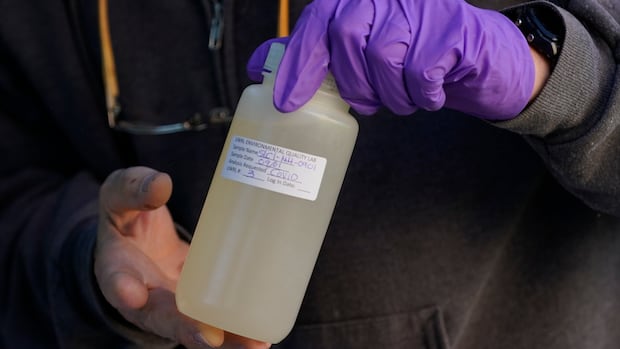[
As Alberta’s measles outbreaks grow, researchers are now watching the province’s wastewater for the highly contagious virus and hoping to determine if the technology could eventually serve as an early detection tool.
The magnitude of Alberta’s outbreaks and the speed at which cases are climbing has sparked widespread concern. As of midday Tuesday, 1,323 cases had been confirmed since the outbreaks began in March.
Piggybacking off weekly wastewater samples, collected through the provincial COVID-19 surveillance program, the team has designed a test that can identify both the wild type measles virus (indicating actual infection) and vaccine-related shedding in the wastewater.
“Wastewater surveillance was shown to be very useful globally — internationally — during COVID-19,” said Dr. Bonita Lee, a co-lead with the pan-Alberta Network for Wastewater Monitoring, which includes researchers from both the University of Alberta and the University of Calgary.
Samples are taken from 12 Alberta wastewater treatment plant sites each week and sent to the provincial lab for analysis.
Once the testing for SARS-CoV-2 is complete, the researchers analyze the same samples for measles.
Without any additional funding, the team began looking for the virus at the beginning of April, after the first cases were confirmed in Edmonton, according to Lee.
They found measles virus signals in the water for that time period and they’ve since tracked provincial trends.
“Basically we have a lot of measles activity and it’s increasing,” said Lee, a professor of infectious diseases in the department of pediatrics at the University of Alberta.
Scientists can’t identify individual cases through this molecular testing. Instead they get a population-level view, she explained.

Alberta’s official measles case count is widely believed, by doctors and scientists, to be an underestimate. And the provincial government’s website acknowledges cases are likely going unreported and undetected in the hardest hit parts of the province.
According to Lee, wastewater monitoring could be most helpful in areas where measles cases may be going undetected and public health officials want to better understand what’s happening.
“It’s never useful by itself. It will always be useful as a supplementary surveillance tool,” she said.
Early detection hopes
Dr. Xiaoli Pang recently retired after working as a virologist in the provincial lab for 25 years and leading the wastewater surveillance program.
Pang developed the initial SARS-CoV2 wastewater monitoring technology for the provincial lab and she designed the molecular test for measles as well.
“I believe measles is going to continue — probably getting worse and worse,” she said, noting funding for wastewater monitoring has been dwindling since the peak of the pandemic.
“Our wastewater plays a very important role. So we really need to continue.”
The incubation period for measles can last up to two weeks, according to Pang, and this has sparked hopes that the technology could lead to earlier detection and provide information that could be used by health officials to take action.
With SARS CoV2 monitoring, the team was able to identify peaks one to two weeks before actual case counts would rise, she said.
They want to know if wastewater signals will work in the same way for measles.

More research is needed, she said, and it would require access to clinical case information data to determine the science behind how the wastewater signals correlate with actual confirmed case counts.
“We want to get clinical information … to compare the correlation. Are we really able to do earlier detection and provide useful information to public health [so they can] make some kind of decisions?” said Pang, a professor in the department of laboratory medicine and pathology at the University of Alberta.
For an effective monitoring program, more frequent sampling would be needed as well, according to the researchers.
Alberta’s wastewater surveillance program has been scaled back since the peak of the pandemic. Testing is done weekly rather than daily, she said, and they have to wait for access to the samples, which means real-time monitoring for measles is not possible.
Measles is highly contagious and can lead to serious complications including pneumonia, brain inflammation, premature delivery and even death.
The vast majority of Alberta’s cases are among the unimmunized and more than 100 Albertans have been hospitalized due to the illness this year.
The team has shared its early findings with provincial health officials.
A spokesperson from the Alberta government confirmed it is aware of the research.
“Researchers from the University of Alberta have been exploring the use of wastewater surveillance for measles,” an emailed statement said.
“Public health officials are reviewing this data to assess its relevance in the context of the current outbreak.”
In the long-term, Pang believes wastewater could play a key role in fighting new and emerging pathogens and even help identify the next pandemic.
She hopes funding will be increased.
“Something may be new coming. If something really causes a huge problem in the near future, I think wastewater [will] play some kind of important role,” she said.
“Wastewater we see as a really important complementary tool, especially for pandemic preparation.”
